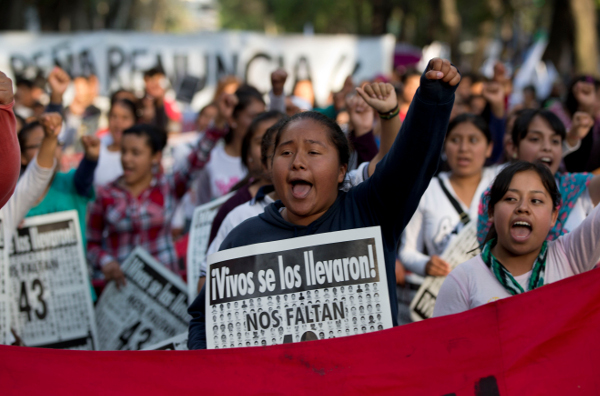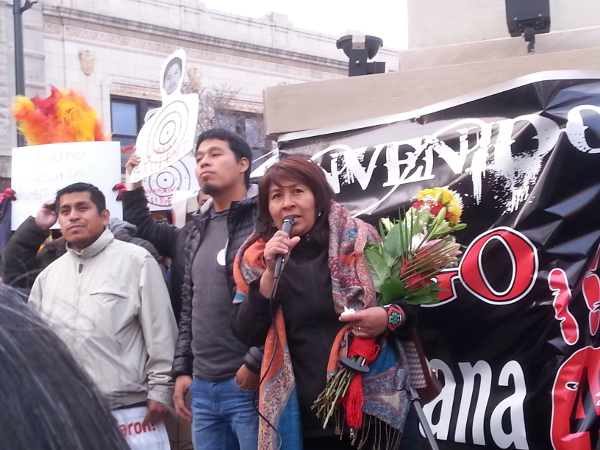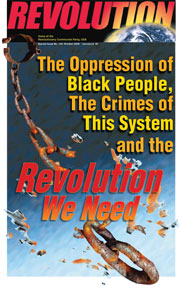On Anniversary of Disappearance of 43 Students
Report Shreds Mexican Government Lies
September 21, 2015 | Revolution Newspaper | revcom.us
 Demonstration in Mexico City in February 2015, with posters saying, "You took them alive, return them alive!" (AP photo)
Demonstration in Mexico City in February 2015, with posters saying, "You took them alive, return them alive!" (AP photo)
It stinks to high heaven: the stench of cover-up by the Mexican state of its central role in the murder and disappearance of college students from Ayotzinapa, Guerrero, is too foul even for official world bodies to ignore.
One year ago, the Mexican government rushed 10,000 soldiers to the area around Iguala in the southern Mexican state of Guerrero to supposedly search for 43 students who were taken away in police vans after a savage assault by police and armed thugs on the buses which the students had commandeered, after a killing spree which executed three students and three passersby and wounded 40 students. The hills around Iguala reeked with dozens of mass graves and hundreds of still-unidentified corpses, dug up mostly by volunteers and families of the thousands of other missing people. But the military campaign was intent only on suppressing the fury and determination of the victims’ families and fellow students, and the state specifically refused for months to even step foot on the military base close to the intersection where the attack occurred.
On September 6, 2015, a group of experts appointed by the Inter-American Human Rights Commission (IACHR) released their report on the September 26, 2014 attack.
For six months the IACHR team interviewed witnesses and detainees and reviewed the government’s evidence and conclusions. Their findings—which confirm what those investigating the case have been uncovering since this atrocity first took place—point to a government cover-up based on the torture-induced confessions of the key witnesses and the destruction, suppression, and distortion of crucial evidence. All this was aimed at casting the blame solely on local corrupt politicians working through the local police and drug gangs and crudely denying the direct involvement of the federal police and the Mexican military.
The UN Group of Forced Disappearances called for Mexico to heed the report and to guarantee that all actions, “including those which involve military authorities, be implemented by the government in a diligent and exhaustive manner.” (emphasis added)
Official Narrative(s)
The Mexican government has floated out several contradictory narratives. First, it claimed that the local police attacked the students, who were leaving the city of Iguala after fundraising in the streets, to prevent them from disrupting a speech by the wife of the mayor of Iguala. Another story is that the students were infiltrated by a gang that is a rival to the dominant regional cartel, Guerreros Unidos, of which the mayor, his wife, and her family were leading members. The mayor and his wife were arrested and remain in jail.
According to this account, the local drug gang took the 43 students from the police station, killed and incinerated them and tossed the burned remains in a river. Much of the government’s “evidence” comes from statements made by people arrested and questioned by the federal police. When huge holes in the official story were exposed, President Enrique Peña Nieto insisted that it was time to “move forward” and “get over this painful moment.”
International Report’s Findings
The findings by the IACHR have exposed to an international audience what independent Mexican investigators had long ago shown: There is considerable evidence that, rather than a crime by corrupt “local” officials, this massacre was overseen and carried out by the federal police and the Mexican military.
- The IACHR report noted that the students did not even arrive in the town of Iguala until one and a half hours after the speech by the mayor’s wife, exposing the absurdity of the government’s claims. Most significantly, the report further shows that the federal police and army intelligence officers from the Iguala military base had been monitoring the movements of the students from the time they first left their school, and had discussed their findings over a communication system called the C4 that links the military with the federal and local police. The Iguala mayor phoned the state and federal police and the military base immediately after the start of the attack, which lasted three hours.
- The evidence of the direct involvement of the army in the killing of the students has been strengthened by an investigation conducted by Anabel Hernandez and Steve Fisher, both fellows with the Investigative Reporting Program at the University of California, Berkeley, which determined the gun casings found at the scene came from weapons used by the Mexican military.
- The government claims it has proof that the students were incinerated in a dump in the nearby town of Cocula. A couple of burned bone fragments, which the government claimed were found in the river, were identified by international DNA experts as belonging to one of the missing students; just this month another tiny fragment was identified as having a “moderate” possibility of belonging to another student. The IACHR report concludes that it was impossible for the magnitude of the fire necessary to incinerate and completely disappear 43 bodies to have taken place at the remote garbage dump. And they found that the one actual bone fragment (found last year) was not burned at a temperature consistent with an incineration, nor is there evidence that it was found at this site.
Government Story Based on Torture
The Mexican government has used the confessions of four suspects they identify as members of the drug gang that allegedly killed the students as crucial evidence for their version of events. But interviews with these suspects and their families have shown they are actually impoverished construction workers who deny involvement and say their “confessions” came after being savagely tortured.
These four witnesses were beaten repeatedly and nearly suffocated by having bags wrapped around their heads, and electric shocks were administered to their genitals. Their torturers also threatened to do the same to their wives and children. A medical examination of the men found pin pricks consistent with electric shocks, and the number of wounds on the four of them were 72, 42, 94, and 60.
What would warrant such an elaborate cover-up, which likely includes the “seeding” of bone fragments of at least one student on top of the thousands of unidentified remains collected in the river? Although the answer is not certain, both scientific experts and historical trajectory point to the logic of the students being cremated or otherwise disappeared at a military base. An ex-general reported that he personally knew that in the 1960s and 1970s, dissidents were secretly burned at crematoria on military bases.
Behind the Disappearance
The Ayotzinapa students had commandeered buses to travel to a demonstration to be held a few days later in Mexico City commemorating the massacre of students at Tlatelolco by the Mexican military in 1968, at the start of the 1968 Olympics. This commandeering of buses, and fundraising from motorists, is a tradition among youths in Mexico. While the federal investigation only mentions four buses, students and other witnesses say they had commandeered five. The report found federal police detained one of the five buses the students were traveling in. Students on the fifth bus say they were stopped by the police and forced out, and ran off. The bus has never been seen since. The report’s theory is that the students had taken over one or more buses carrying heroin bound for the U.S. Midwest, or drug money being sent back.
According to the report, “Public information shows that Iguala is a shipment and transport point for drugs, especially heroin, to the United States, and especially Chicago.” And according to the affidavit by a United States Drug Enforcement Administration agent last year, the alleged local boss of Guerreros Unidos in Chicago “worked with individuals in Mexico and the Chicago area to transport and distribute narcotics that were concealed in commercial passenger buses that traveled between Mexico and Chicago.” (“New Report Offers Most Plausible Explanation Yet for Attack on 43 Mexican Students,” Roque Planas, huffingtonpost.com, September 9, 2015)
This missing fifth bus and its possible cargo of hidden drugs may be ONE factor behind what happened on that night in Iguala, but the hypothesis that it is the “most plausible explanation” fails to even touch on the historical context for the repression of these students in particular.
WHY were the military and federal police ALREADY coordinating surveillance of the students via C4 long before they commandeered the buses?
WHY were two Ayotzinapa students shot to death by police during a protest in 2013?
WHY did national politicians immediately try to use the crisis in Iguala as an excuse to call for closing this and other rural teachers colleges?
The truth—which no “official body” wants to touch—is that Mexican rural teachers colleges are a breeding ground for radical and revolutionary ideas and organization, with deep roots in the indigenous and impoverished peasantry. For this reason, and also as part of a major move toward a neoliberal program in Mexico that breaks with aspects of the state’s historical claim to represent the institutionalization of the revolution, there has been a concerted effort to close or severely limit the rural teachers colleges and to repress the independent teachers’ movement.
Family Members Call for Major Mobilizations on One-Year Anniversary
 Chicago, April 4, 2015: María de Jesús Tlatempa Bello, mother of the disappeared student Jose Eduardo, speaks at a march and rally in Chicago in support of victims of the massacre and kidnapping of 43 Ayotzinapa students in southern Mexico. One of the main slogans of the Caravana43 is "¡Vivos se los llevaron, vivos los queremos!" (Alive You Took Them, We Want Them Alive!) Photo: Special to revcom.us
Chicago, April 4, 2015: María de Jesús Tlatempa Bello, mother of the disappeared student Jose Eduardo, speaks at a march and rally in Chicago in support of victims of the massacre and kidnapping of 43 Ayotzinapa students in southern Mexico. One of the main slogans of the Caravana43 is "¡Vivos se los llevaron, vivos los queremos!" (Alive You Took Them, We Want Them Alive!) Photo: Special to revcom.us
Over the past year, people in dozens of cities and towns have taken back control of their communities from organized drug cartels and the authorities that are tied to them. In the approach to the June elections, sharp and controversial struggle was waged in southern Mexico, with Ayotzinapa forces and teachers as a key element, to boycott and prevent the elections as a farce in a number of areas, chasing out political campaigners, occupying polling places, destroying ballot boxes, and defending themselves against heavy repression from thousands of troops and paramilitary assault forces organized by the state. The Mexican government and army have responded with even more blatant repression, targeting and killing people in these movements in different confrontations.
In response to the disappearance of the 43 students, the families and fellow students of those missing have organized international caravans speaking in major cities in the U.S., Latin America, and Europe, calling on people around the world to support their demand for justice—and drawing world attention to the crimes being carried out in Mexico by the drug cartels with complicity by governmental officials, which have turned large parts of Mexico into a war zone and graveyard. They are creating political problems for the Mexican and U.S. governments internationally.
They raised the demand that the U.S. stop funding the Mexican military, which has been complicit with the drug cartels in the killings of over 100,000 Mexican people and over 25,000 disappeared in the past eight years. For some this reflects a hope that the U.S. can force the Mexican government to act in the interests of the Mexican people. Others are beginning to recognize that the U.S. imperialists cannot be a part of the “solution”—they are in fact the major part of the problem. It is also significant that the tours specifically rejected reliance on any electoral parties or politicians.
In the name of financing Mexico’s “war on drugs” and “securing the border,” the U.S. gave $1 billion to the previous Mexican regime of Felipe Calderón, and is now giving money to the current Peña Nieto government, along with arms and technology to equip and train Mexico’s army, navy, federal police, and municipal and state police—the very forces that are deeply complicit with the drug cartels. This major backing is based on the interests of the U.S. imperialists in maintaining their domination and control over Mexico.
* * * *
Major international mobilizations are taking place on September 26, the one-year anniversary of this crime by the Mexican state. People everywhere should stand with those who are denouncing this atrocity and the hand of the Mexican and U.S. governments behind it, raising these demands:
Stop the War on the People!
From Iguala to the Presidential Palace, put the killers in jail! The whole damn system is guilty!
The state is not negligent, it is criminal! Only the people will bring justice!
Volunteers Needed... for revcom.us and Revolution
If you like this article, subscribe, donate to and sustain Revolution newspaper.







